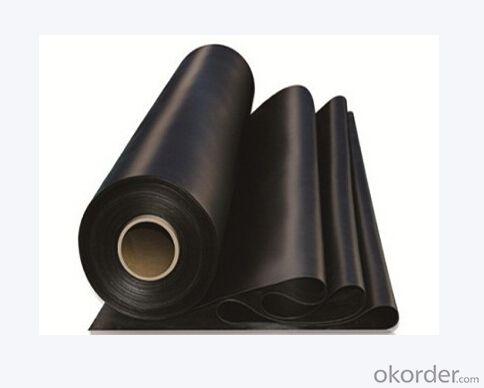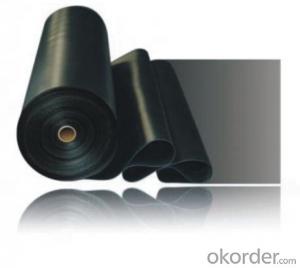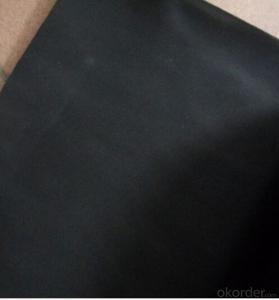Width 2m EPDM Waterproofing Membrane for Roof Use
- Loading Port:
- Qingdao
- Payment Terms:
- TT OR LC
- Min Order Qty:
- 2000 m²
- Supply Capability:
- 100000 m²/month
OKorder Service Pledge
OKorder Financial Service
You Might Also Like
EPDM waterproofing Rubber membrane
1. Product Description of EPDM Waterproofing Membrane:
EPDM Waterproofing Membrane is the modified materials which is widely used at home and abroad in the kinds of roofs, tunnel, basement such sorts of constructions' waterproofing.
They are based upon EPDM rubber with modifier, softener and accelerant assistants added to provide flexibility and stability . Through the precise ingredients, mixing, extrusion, rolling, curing processes to made of modified EPDM Waterproofing material with high strength and high flexibility.
2. Product Features of EPDM Waterproofing Membrane:
1). Great tensile strength,long-range elasticity and aging resistant.
2). Excellent heat reisistant and can be used under -70°C~~+110°C .
3).Good anti-corrosion, ultraviolet resistant, root penetration resistance
4).Long life use over 50 years and used longer 100 years or more under the condition of buried in the ground.
5).Light and easy to install.
3. Product Sepcification of EPDM Waterproofing Membrane:
Thickness : 0.3-2.0mm
Width :1-4m
Length: 15-50m/roll
Item | value | ||
JL1 | JF1 | ||
Tensile Strength (Mpa) | normal tamperature | 7.5 | 4.0 |
60°C ≥ | 2.3 | 0.8 | |
Elongation at break (%) | normal tamperature ≥ | 450 | 450 |
-20°C ≥ | 200 | 200 | |
Tear Resistance (N) | ≥ | 25 | 18 |
Water impermeability | 30mm | 0.3Mpa | 0.3Mpa |
Cold bending | (°C) ≤ | -40 | -30 |
Heating Shrinking rate | extand < | 2 | 2 |
shrink < | 4 | 4 | |
4.Product Application of EPDM Waterproofing Membrane:

4. Some photos:


- Q:Can a waterproofing membrane be used for a tunnel waterproofing system?
- Yes, a waterproofing membrane can be used for a tunnel waterproofing system. A waterproofing membrane is a flexible and durable material that is designed to prevent the ingress of water into a structure. It is commonly used in various construction projects, including tunnels, to provide an effective barrier against water penetration. In a tunnel waterproofing system, the membrane is typically applied to the exterior walls and floor of the tunnel. It is installed in multiple layers to ensure a watertight seal and to provide long-term protection against water infiltration. The membrane acts as a barrier, preventing water from seeping through the concrete or other tunnel materials. There are different types of waterproofing membranes available, including bituminous, PVC, and liquid-applied membranes. The selection of the appropriate membrane depends on factors such as the type of tunnel construction, the level of water pressure, and the specific requirements of the project. It is important to carefully choose and install the waterproofing membrane to ensure its effectiveness. Proper surface preparation, including cleaning and smoothing the substrate, is essential for achieving a good bond between the membrane and the tunnel surface. Additionally, attention should be given to properly sealing any joints, penetrations, or connections in the membrane to prevent water from finding its way through. Overall, a waterproofing membrane is a reliable and widely used solution for tunnel waterproofing systems. When properly selected and installed, it provides an effective barrier against water ingress, ensuring the durability and longevity of the tunnel structure.
- Q:Can a waterproofing membrane be used for oil or gas industry applications?
- Yes, a waterproofing membrane can be used for oil or gas industry applications. Waterproofing membranes are designed to provide a barrier against water penetration, which can be beneficial in industries where oil or gas leaks and spills are a concern. These membranes can help prevent water from seeping into underground storage tanks or pipelines, protecting them from corrosion and potential environmental contamination. Additionally, waterproofing membranes can be used in areas where oil or gas may come into contact with water, such as containment areas or waste treatment facilities, to ensure that no substances leak into the surrounding environment. Overall, waterproofing membranes offer a reliable solution for protecting oil or gas industry infrastructure from water-related damage and can contribute to maintaining the integrity and safety of these operations.
- Q:Can waterproofing membranes be used on swimming pool decks?
- Yes, waterproofing membranes can be used on swimming pool decks. Waterproofing membranes are designed to create a barrier against water penetration, making them an ideal solution for areas that are constantly exposed to water, such as swimming pool decks. By applying a waterproofing membrane to the deck surface, it helps to prevent any water from seeping through and causing damage to the underlying structure. Additionally, waterproofing membranes can also provide protection against chemicals, UV rays, and general wear and tear, which are common in swimming pool environments. Overall, using waterproofing membranes on swimming pool decks can help extend their lifespan, reduce maintenance costs, and enhance the overall safety and appearance of the area.
- Q:Can a waterproofing membrane be used for temporary structures or tents?
- Yes, a waterproofing membrane can be used for temporary structures or tents. It provides an effective barrier against water infiltration, helping to keep the interior dry and protected from outside elements. This can be especially useful in temporary structures or tents where water resistance is crucial for comfort and safety.
- Q:Can a waterproofing membrane be used for a garden pond liner?
- Yes, a waterproofing membrane can be used as a garden pond liner. Waterproofing membranes are designed to prevent water penetration, making them an effective option for creating a watertight barrier in a garden pond.
- Q:Can a waterproofing membrane be used on plastic surfaces?
- Yes, a waterproofing membrane can be used on plastic surfaces. Waterproofing membranes are designed to provide a protective barrier against water penetration, and they can adhere to a variety of surfaces, including plastic. The key factor in ensuring a successful application is proper surface preparation. The plastic surface should be clean, dry, and free from any dirt, dust, or oils that may interfere with the adhesion of the membrane. Additionally, it is important to choose a waterproofing membrane that is compatible with plastic surfaces and can flex and expand with the material to prevent cracking or peeling. By following the manufacturer's guidelines and using a suitable product, a waterproofing membrane can effectively seal and protect plastic surfaces from water damage.
- Q:Can a waterproofing membrane be used for underground parking garages?
- Underground parking garages greatly benefit from the utilization of a waterproofing membrane. To safeguard against water infiltration and consequent harm, it is highly advised to employ such a membrane in these specific structures. Surrounding soil often poses a threat of water seepage in underground parking garages, leading to structural decline, corrosion of steel reinforcements, and the proliferation of mold and mildew due to constant exposure to moisture. A waterproofing membrane acts as a protective barrier, effectively preventing water from permeating the walls and floors of the garage. It is carefully applied to the exterior surfaces of the structure, forming a shield that ensures the interior remains dry and devoid of water-related issues. The selection of the appropriate membrane should be based on project-specific requirements, taking into account factors such as construction materials, groundwater conditions, and expected water pressure levels. Furthermore, proper installation techniques and regular maintenance are paramount to ensure the long-term efficacy of the waterproofing system.
- Q:Can a waterproofing membrane be used in tunnels?
- Indeed, tunnels can indeed employ a waterproofing membrane. These membranes are frequently utilized in tunnels to thwart water infiltration and safeguard the structure from water-related harm. Generally composed of materials like bitumen, PVC, or polyurethane, these membranes possess impermeability to water as a core characteristic. When properly applied, a waterproofing membrane can act as a formidable barrier against water infiltration, thereby preserving the tunnel's integrity and avoiding expensive structural impairment. Furthermore, apart from their water-resistant properties, waterproofing membranes also provide defense against other substances like chemicals and gases, rendering them a versatile remedy for both tunnel construction and upkeep.
- Q:What type of maintenance is required for a waterproofing membrane?
- Regular maintenance is required for a waterproofing membrane to ensure its effectiveness and longevity. This maintenance typically includes inspecting the membrane for any signs of damage, such as cracks or tears, and promptly repairing them. Additionally, it is important to keep the membrane clean and free from debris to prevent clogging or blockages. Regular inspections and maintenance will help to extend the life of the waterproofing membrane and ensure it continues to effectively protect the underlying structure.
- Q:Can waterproofing membranes be used on elevator pits?
- Indeed, elevator pits can benefit from the utilization of waterproofing membranes. Given their underground location, elevator pits are susceptible to water infiltration, which can lead to detrimental water damage and leaks. To combat these moisture-related issues, waterproofing membranes offer a highly effective solution by preventing water penetration and safeguarding elevator pits. Typically composed of rubber, polyurethane, or bitumen, these membranes are specifically designed to create a watertight barrier. Through their application on the walls and floor of the elevator pit, they form a seamless and durable protective layer. As a result, this membrane system ensures the maintenance of a dry pit, consequently preventing water damage to the elevator components and ensuring the safe and reliable operation of the elevator.
1. Manufacturer Overview |
|
|---|---|
| Location | |
| Year Established | |
| Annual Output Value | |
| Main Markets | |
| Company Certifications | |
2. Manufacturer Certificates |
|
|---|---|
| a) Certification Name | |
| Range | |
| Reference | |
| Validity Period | |
3. Manufacturer Capability |
|
|---|---|
| a)Trade Capacity | |
| Nearest Port | |
| Export Percentage | |
| No.of Employees in Trade Department | |
| Language Spoken: | |
| b)Factory Information | |
| Factory Size: | |
| No. of Production Lines | |
| Contract Manufacturing | |
| Product Price Range | |
Send your message to us
Width 2m EPDM Waterproofing Membrane for Roof Use
- Loading Port:
- Qingdao
- Payment Terms:
- TT OR LC
- Min Order Qty:
- 2000 m²
- Supply Capability:
- 100000 m²/month
OKorder Service Pledge
OKorder Financial Service
Similar products
New products
Hot products
Related keywords





























